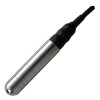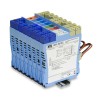Ratiometric is used to describe an output signal which changes in proportion to a change input or supply voltage.
A typical ratiometric device would be a strain gauge output pressure sensor, where the output sensitivity is described as a ratio between output and input supply voltage.
If the sensor is described as having a 3 mV/V ratiometric output sensitivity, this means that the full span output will increase by 3 millivolts for every 1 volt increase in supply voltage.
Featured strain gauge based measurement products
 IMSL IP68 Stainless Steel 316L Hydrostatic Pressure Sensor - Water resistant pressure sensor for measuring hydrostatic pressures in the range of 0-0.5 mWC up to 0-100 mWC.
IMSL IP68 Stainless Steel 316L Hydrostatic Pressure Sensor - Water resistant pressure sensor for measuring hydrostatic pressures in the range of 0-0.5 mWC up to 0-100 mWC. Ceramic Thick Film Pressure Sensors - This is a type of sensor which utilises a measurement technology that comprises of a ceramic diaphragm and thick film strain gauges to measure pressure.
Ceramic Thick Film Pressure Sensors - This is a type of sensor which utilises a measurement technology that comprises of a ceramic diaphragm and thick film strain gauges to measure pressure.
Glossary of Measurement Signal technical terms
- 2 Wire
- 3 Wire
- 4 to 20 mA Current Loop Output Signal
- 4 Wire
- Amplified Voltage Output
- BFSG – Bonded Foil Strain Gauge
- Deadband
- FSO – Full Scale Output
- HART®
- mV/V – Millivolts per Volt Output Signal
- NC – Normally Closed
- NO – Normally Open
- Piezoresistive Strain Gauges
- Span
- Span Offset
- Span Sensitivity
- Square Root Extraction
- Threshold
- Totalizer
- Transducer
- Transmitter
- TSL – Terminal Straight Line
- TSS – Thermal Span or Sensitivity Shift
- Turndown Ratio
- USB
- Vented Cable
- Wheatstone Bridge Strain Gauge
- Zero Offset
- Zero Tare
Help from Measurement Signal resources
- Why use 4-20mA and 3-15 psi rather than 0-20mA & 0-15psi
- Supply voltage and load resistance considerations for pressure transmitters
- What is the difference between zero offset and zero drift?




